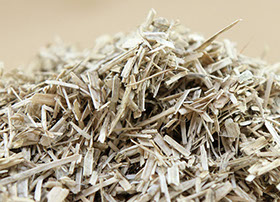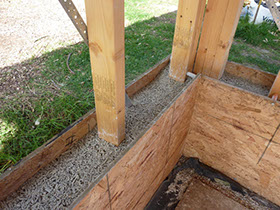


Hemp-shiv
Hempcrete properties
Hempcrete shutter casting
If you are seeking a building material towards achieving an all round ecological, economical and best possible building fabric performance, hempcrete offers exceptionally compelling properties worthy of serious consideration.
Known as one of the first human cultivated plant types and one of the fastest growing; and capable of mature crop every year, hemp uniquely requires little or no pesticides in it's farming.
With literally thousands of uses, from textiles, medicines, foods, paper and many uses within the building industry, hemp is again being commercially rediscovered in a few countries including the UK, France, Canada, Australia and parts of the USA following the advent of the cotton, wood pulp paper and petrochemicals industries that caused hemp to fall out of common use.
As a building material, the woody centre of the hemp plant known as 'hemp-shiv' is mixed with lime and water to form 'hempcrete', which is typically cast in layers between removable shuttering around a structural timber frame, or installed in pre-cast blocks or even sprayed in situ as an additional breathable insulating layer, offering pre-exisiting or historical buildings a particularly attractive renovation solution.
Properties:
Offering a range of inherent and resultant sustainability properties hempcrete is also attracting the attention of both wine and food producers such as Chateau Maris and Marks & Spencer. With a typical build-up finished with lime render, cladding, breathable paints, or even left raw with no requirement for a vapour barrier, at a thickness of 350mm hempcrete achieves an insulation u-value of 0.17 W/m2K together with a thermal mass capable of maintaining an internal ambient temperature of 14ºc (56ºf) irrespective of external temperature!
'Better than carbon negative and ultra low fuel bills'
As an intriguingly ecological and economical building solution resulting in minimal heating requirements and ultra-low fuel bills, a hempcrete building is also inherently hygroscopic (naturally vapour permeable), damp free, breathable and carbon negative, embodying more carbon than it takes to produce and actively continuing to capture carbon over it's life time as it 'breathes'. And unlike most other passivhaus capable solutions, mechanical-ventilation-heat-recovery (MVHR) is also not essential.
Game changing!
With construction, operation and maintenance of buildings responsible for around 40% of the UK's total carbon emissions, hempcrete along with other commercially 'grown' building materials could offer truly powerful game changing potential.
November 2019
design@number39.co.uk
+447940925738

